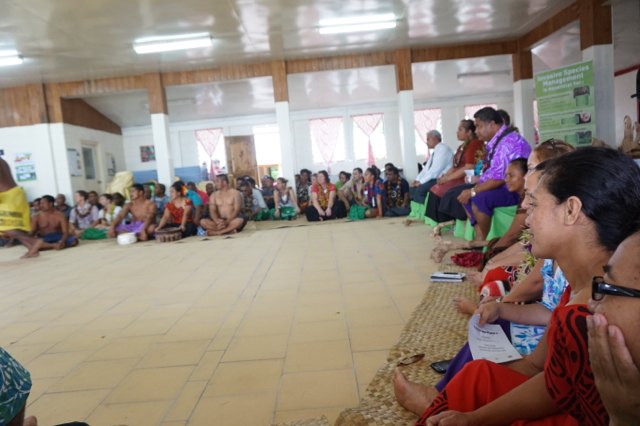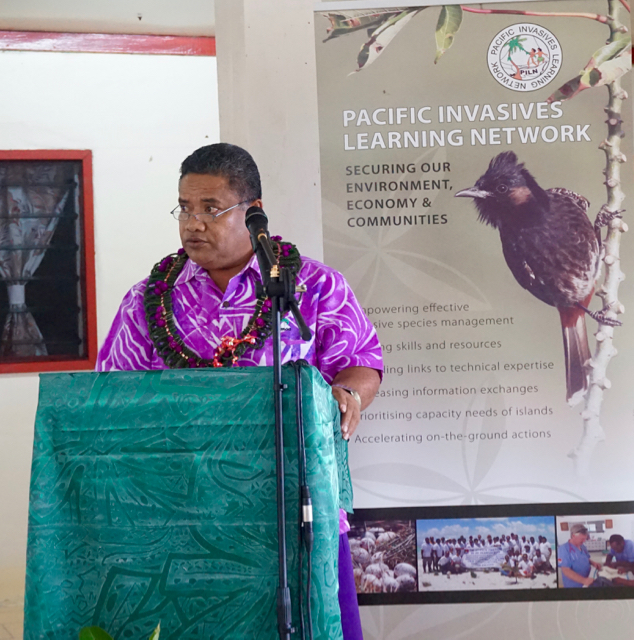
Biodiversity Conservation
Ten years after its creation, the Pacific Invasives Learning Network is meeting in Samoa for the first time, with Samoan PILN members proudly participating in a traditional ava ceremony and other Samoan hospitality.
 The official ava ceremony to welcome the participants of PILN2016. Photo: SPREP.
The official ava ceremony to welcome the participants of PILN2016. Photo: SPREP.
The village of Lepā welcomed the PILN2016 participants, who represent 16 Pacific island countries and territories, each battling invasive species that harm crops, people, and environments. Samoa's Ministry of Natural Resources and Environment is co-hosting the meeting along with the Secretariat of the Pacific Regional Environment Programme (SPREP).
"Environment is a very broad concept,that covers almost everything", said the Honorable Taefu Lima Taefu, Associate Minister of the Ministry of Natural Resources and Environment, "and environment is about choices that we make each day."
The minister noted that tackling invasive species will increase our capacity to be environmentally resilient, a global target given that 14 of the 17 Sustainable Development Goals are directly or indirectly related to environmental issues.
 Taefu Lemi Taefu, Associate Minister for the Ministry of Natural Resources and Environment, delivering the opening address of PILN2016. Photo: SPREP
Taefu Lemi Taefu, Associate Minister for the Ministry of Natural Resources and Environment, delivering the opening address of PILN2016. Photo: SPREP
Some invasive species have been with us for a long time, and there is always the risk of bringing new species. Gesturing toward a display of models of native Pacific vessels, the minister joked - "These canoes may have contributed to invasive species in Samoa".
"Whatever and wherever they are, invasive species are a real threat and real challenge. I urge you to continue the fight: battle against invasive species in your respective environment", said the Honorable Taefu Lima Taefu. "Preventing and stopping the spread of invasive species is everyone's responsibility."
Invasive species cause more extinctions of endemic Pacific species than any other single cause. The Pacific has a high proportion of endemic species, which are found no where else, but also has an extremely high rate of extinction.
"Our job here is to protect the biodiversity hotspots that we all belong to", said Mr Roger Cornforth, Deputy Director General of SPREP. He called on the participants to "bring your expertise, and work with local people to address the issues".
PILN brings experts together to support each other, particularly helpful because many of the same species are invasive across the Pacific islands.
"The Pacific is the envy of other regions because we are lucky to have regional mechanisms supporting the fight against invasive species, such as PILN, the Pacific Invasives Partnerships, a set of regional Guidelines for Invasive Species Management in the Pacific, and Council of Regional Organisations in the Pacific - agencies such as SPREP and the Pacific Community," said Mr David Moverley, Invasive Species Adviser of SPREP. Now, all except three Pacific countries and territories have a PILN team.
A network depends on the engagement of its members. PILN works because of trusting teams that are positive and open, just like the Samoan welcome at Lepā.
For more information, please contact Mr David Moverley, [email protected]
 The official ava ceremony to welcome the participants of PILN2016. Photo: SPREP.
The official ava ceremony to welcome the participants of PILN2016. Photo: SPREP.The village of Lepā welcomed the PILN2016 participants, who represent 16 Pacific island countries and territories, each battling invasive species that harm crops, people, and environments. Samoa's Ministry of Natural Resources and Environment is co-hosting the meeting along with the Secretariat of the Pacific Regional Environment Programme (SPREP).
"Environment is a very broad concept,that covers almost everything", said the Honorable Taefu Lima Taefu, Associate Minister of the Ministry of Natural Resources and Environment, "and environment is about choices that we make each day."
The minister noted that tackling invasive species will increase our capacity to be environmentally resilient, a global target given that 14 of the 17 Sustainable Development Goals are directly or indirectly related to environmental issues.
 Taefu Lemi Taefu, Associate Minister for the Ministry of Natural Resources and Environment, delivering the opening address of PILN2016. Photo: SPREP
Taefu Lemi Taefu, Associate Minister for the Ministry of Natural Resources and Environment, delivering the opening address of PILN2016. Photo: SPREP"Whatever and wherever they are, invasive species are a real threat and real challenge. I urge you to continue the fight: battle against invasive species in your respective environment", said the Honorable Taefu Lima Taefu. "Preventing and stopping the spread of invasive species is everyone's responsibility."
Invasive species cause more extinctions of endemic Pacific species than any other single cause. The Pacific has a high proportion of endemic species, which are found no where else, but also has an extremely high rate of extinction.
"Our job here is to protect the biodiversity hotspots that we all belong to", said Mr Roger Cornforth, Deputy Director General of SPREP. He called on the participants to "bring your expertise, and work with local people to address the issues".
PILN brings experts together to support each other, particularly helpful because many of the same species are invasive across the Pacific islands.
"The Pacific is the envy of other regions because we are lucky to have regional mechanisms supporting the fight against invasive species, such as PILN, the Pacific Invasives Partnerships, a set of regional Guidelines for Invasive Species Management in the Pacific, and Council of Regional Organisations in the Pacific - agencies such as SPREP and the Pacific Community," said Mr David Moverley, Invasive Species Adviser of SPREP. Now, all except three Pacific countries and territories have a PILN team.
A network depends on the engagement of its members. PILN works because of trusting teams that are positive and open, just like the Samoan welcome at Lepā.
For more information, please contact Mr David Moverley, [email protected]